Optimizing the Quality of Service of Mobile Broadband Networks for a Dense Urban Environment
Abstract
1. Introduction
1.1. Key Contributions
- We provide an extensive 4G LTE mapping and signal performance measurement overview in UNILAG, Ikorodu, and Oniru VI of Lagos, Nigeria. As a fast-growing economy, Lagos provides a thriving environment for adopting networking optimization. This can serve as the bedrock for improved network performance and user experience.
- A detailed analysis and data visualization of the measured parameters has been performed using MATLAB R2021a and presented in appropriate tables and figures. The decision to use the data as obtained for the analysis makes the results obtained closer to reality than if the choice of completing missing data was adopted.
- The relevance of adopting a multidimensional approach in the examination of the QoS and QoE of 4G LTE through metrics such as RSRP, RSRQ, SINR, throughput downlink (DL), and uplink (UL), rather than using a single parameter, will also be tested.
- The specific optimized value range for metrics such as the RSRP, RSRQ, and SINR are suggested, while recommendations for implementing the optimized values for all the test environments are made in line with the specific challenges in the areas.
1.2. Paper Organization
2. Theoretical Background
2.1. Related Work
2.2. Long-Term Evolution (LTE)
2.3. Optimization
- Modeling the 4G network: First, a network model is developed taking into account the physical characteristics of the network, operational base stations, active users, the frequency spectrum available, and the user’s proximity to a base station.
- Defining the objective function: A mathematical representation of the QoS metric to be optimized is developed within a predetermined boundary. For example, in the case of 4G networks, common objective functions may include maximizing the data rate, minimizing the latency, or maximizing the energy efficiency of the network.
- Selecting the optimization algorithm: Depending on the objective function and the characteristics of the 4G network, an informed choice can be made between applying PSO or HSO as the optimization algorithm. For example, if the objective function is complex and the network is large, HSO may be a better choice. On the other hand, if the objective function is simple and the network is small, PSO may be a more efficient choice.
- Implementing the algorithm in MATLAB: Once the optimization algorithm has been selected, a thorough implementation in MATLAB is required. This will involve writing code that implements the algorithm, defining the parameters for the optimization, and setting up the objective function.
- Running the optimization: Once the algorithm has been implemented in MATLAB, the optimization can then be run, specifying the initial conditions and the number of iterations. The algorithm will then iteratively update the parameters of the network until the objective function is optimized.
- Analyzing the results: Finally, the optimization results can be further examined to determine the optimal configuration of the 4G network. This may involve plotting the results, comparing the results to the baseline, or determining the impact of the optimization on the QoS metric.
3. Experimental Design
3.1. Materials and Experimental Setup
- Allows minimal modification of the terminal device and requires less technical knowledge.
- Automatic measurement and logging of DT data at rapid and programmable sessions.
- Mobility and ease of installation across multiple operating systems (for example, Windows, Linux, Mac).
- Universal and applicable across different terminal devices, such as mobile phones, for measuring network parameters without special equipment.
3.2. Relevant 4G LTE Performance Metrics
3.2.1. Reference Signal Received Power
3.2.2. Reference Signal Received Quality
3.2.3. Received Signal Strength Indicator
3.2.4. Signal-to-Noise plus Interference Ratio
3.2.5. Throughput
- ,
- .
- =
- =
3.3. Drive Test Procedure
3.4. Measurement Parameters
3.5. Optimization Algorithm
- particle’s index, specifying the particle to be examined;
- dimension being considered, each particle has a position and a velocity for each dimension;
- describes the iteration number of the process;
- position of the ith particle in dimension ;
- velocity of the ith particle in dimension ;
- constant for the cognitive acceleration component;
- stochastic component of the algorithm, a random value between 0 and 1;
- a location in dimension d that intercepts with the best locations in the dimension of particle ;
- constant for the cognitive and social components;
- a location in dimension d that intercepts with the visited locations in the dimension of all the particles.
| Algorithm 1: PSO algorithm with the objective function, the upper and lower bound for obtaining the global and personal best positions and velocities of a swarm |
| Input: : particle’s index, specifying the particle to be examined : dimension being considered : describes the iteration number of the process : position of the ith particle in dimension d : velocity of the ith particle in dimension d : constant for the cognitive acceleration component : stochastic component of the algorithm : a location in dimension d that intercepts with the best locations in the dimension of the particle : constant for the cognitive, and social component : a location in dimension d that intercepts with the visited locations in the dimension of all the particles t: time of iteration Output: Optimized global best positions : Optimized personal best positions 1. START 2. % Initialize the swarm 3. for i = 1 to Population size do 4. % Populate the swarm 5. = random initialization within bounds 6. = random initialization within bounds 7. 8. % Ensure all particles are within the sample size 9. > max permissible limit 10. = max permissible limit 11. < min permissible limit 12. = min permissible limit 13. end if 14. 15. % Evaluate the objective function for the current position 16. ) 17. 18. % Initialize the personal best for each particle 19. 20. 21. % Update the global best if the current particle is better 22. 23. 24. 25. end if 26. end for 27. 28. % Perform PSO iterations 29. for it = 1 to Max iterations do 30. for i = 1 to Population size do 31. % Update the velocity and position of each particle 32. 33. 34. 35. % Check that optimized results are within max and min permissible limits 36. > max permissible limit 37. = max permissible limit 38. else if < min permissible limit 39. = min permissible limit 40. end if 41. 42. % Evaluate the objective function for the new position 43. ) 44. 45. % Update the personal best if the new position is better 46. < f_pbest_i 47. 48. 49. end if 50. 51. % Update the global best if the new position is better 52. 53. 54. 55. end if 56. end for 57. end for 58. 59. % Output the optimized global and personal best positions 60. 61. 62. STOP |
4. Results and Discussions
4.1. Extensive 4G LTE Mapping and Signal Performance Measurement
4.2. Statistical Data Analysis and Visualization of Measured Data
4.3. The Measure of Data Distribution
4.3.1. A Multidimensional Approach to the Examination of the QoS Obtained
4.3.2. Probability Density
4.4. Optimization Results for the Specific Metrics
| Algorithm 2: PSO algorithm with the objective function, the upper and lower bound for obtaining the global and personal best positions and velocities of a swarm |
| Input: objective function () upper and lower bound of the search space population size () maximum number of generations inertia weight cognitive constant social constant Output: Optimized global best value : Optimized personal best value 1. START 2. % Step 1: Initialization 3. for i = 1:N 4. = random initialization within the search space 5. = zeros(1,dimension) % Initialize velocity to zero 6. 7. 8. end for 9. 10. % Initialize global best position and fitness 11. 12. 13. 14. % Step 2: Main loop 15. 16. % Loop through each particle in the swarm 17. for i = 1:N 18. % Step 3: Update particle velocity and position 19. 20. 21. 22. 23. % Step 4: Check if the new position is within bounds 24. % Apply boundary conditions 25. for d = 1: dimension 26. then 27. 28. % Reverse velocity if out of bounds 29. 30. 31. 32. end if 33. end for 34. 35. % Step 5: Update personal best 36. 37. 38. 39. = fitness 40. end if 41. 42. end for 43. 44. % Step 6: Update global best 45. 46. 47. 48. 49. end if 50. 51. end for 52. STOP |
4.5. Discussion of Results
4.6. Findings
- The RSRP or any other relevant KPI is not sufficient enough on its own to determine the QoS of an MNO, as observed from the UE.
- To get better MBB performance in Lagos, especially the sample space researched, a thorough mapping and possible replanning of the routes and the hardware used may be necessary.
- From the probability distribution functions, the chances of getting the best value obtained from the PSO optimization are 0.02, 0.018, and 0.035 in UNILAG, Ikorodu, and Oniru VI, respectively.
- For instance, in areas such as UNILAG, the QoS of one user at a location with good receptivity is greatly dwarfed by the experience of a user at a location with poor reception.
- Though there seems to be a consistency in value with the data obtained in Oniru VI, the measured values generally indicated poorer user experience in that area.
5. Conclusions
Author Contributions
Funding
Institutional Review Board Statement
Informed Consent Statement
Data Availability Statement
Conflicts of Interest
Abbreviations
| Abbreviation | Meaning |
| 4G | Fourth Generation |
| 5G | Fifth Generation |
| BTS | Base Transceiver Station |
| CPW | Coplanar Waveguide |
| CSV | Comma Separated Values |
| DL | Downlink |
| DPE | Direct Position Estimation |
| DT | Drive Test |
| eMBB | Enhanced Mobile Broadband |
| UE | User Equipment |
| FDD | Frequency Division Duplex |
| GPS | Global Positioning System |
| IoT | Internet of Things |
| KPIs | Key Performance Indicators |
| LDPC | Low-Density Parity-Check |
| LTE | Long Term Evolution |
| MATLAB | Matrix Laboratory |
| MIMO | Multiple Input Multiple Output |
| ML | Maximum Likelihood |
| MNOs | Mobile Network Operators |
| mMIMO | Massive Multiple Input Multiple Output |
| mMTC | Massive Machine-Type Communication |
| mmWaves | Millimeter waves |
| NCC | Nigerian Communications Commission |
| OFDMA | Orthogonal Frequency Division Multiple Access |
| PCC PHY DL Throughput | Physical Channel Control Downlink Throughput |
| PDCP DL Throughput | Packet Data Convergence Protocol Downlink Throughput |
| RMSE | Root Mean Square Error |
| UL | Uplink |
| UMTS | Universal Mobile Telecommunication Service |
| URLLC | Ultra-Reliable Low-Latency |
| V2X | Vehicle-to-Everything |
| WiMAX | World Wide Interoperability for Microwave Access |
References
- El-Saleh, A.A.; Alhammadi, A.; Shayea, I.; Hassan, W.H.; Honnurvali, M.S.; Daradkeh, Y.I. Measurement Analysis and Performance Evaluation of Mobile Broadband Cellular Networks in a Populated City. Alex. Eng. J. 2023, 66, 927–946. [Google Scholar] [CrossRef]
- Imoize, A.L.; Obakhena, H.I.; Anyasi, F.I.; Sur, S.N. A Review of Energy Efficiency and Power Control Schemes in Ultra-Dense Cell-Free Massive MIMO Systems for Sustainable 6G Wireless Communication. Sustainability 2022, 14, 11100. [Google Scholar] [CrossRef]
- Ogundokun, R.O.; Awotunde, J.B.; Imoize, A.L.; Li, C.T.; Abdulahi, A.T.; Adelodun, A.B.; Sur, S.N.; Lee, C.C. Non-Orthogonal Multiple Access Enabled Mobile Edge Computing in 6G Communications: A Systematic Literature Review. Sustainability 2023, 15, 7315. [Google Scholar] [CrossRef]
- Silalahi, L.M.; Simanjuntak, I.U.V.; Budiyanto, S.; Silaban, F.A.; Rochendi, A.D.; Osman, G. Analysis of Lte 900 Implementation to Increase Coverage and Capacity of 4g Lte Network on Telkomsel Provider. In Conference on Broad Exposure to Science and Technology 2021 (BEST 2021); Atlantis Press: Amsterdam, The Netherlands, 2022. [Google Scholar]
- Taheribakhsh, M.; Jafari, A.; Peiro, M.M.; Kazemifard, N. 5G Implementation: Major Issues and Challenges. In Proceedings of the 2020 25th International Computer Conference, Computer Society of Iran (CSICC), Tehran, Iran, 1–2 January 2020; IEEE: Piscataway, NJ, USA, 2020; pp. 1–5. [Google Scholar]
- Alexis, C. Madrigal Waymo’s Robots Drove More Miles Than Everyone Else Combined. Available online: https://www.theatlantic.com/technology/archive/2019/02/the-latest-self-driving-car-statistics-from-california/582763/ (accessed on 9 April 2023).
- Shamaei, K.; Kassas, Z.M. Receiver Design and Time of Arrival Estimation for Opportunistic Localization with 5G Signals. IEEE Trans. Wirel. Commun. 2021, 20, 4716–4731. [Google Scholar] [CrossRef]
- Fascista, A.; Coluccia, A.; Ricci, G. A Pseudo Maximum Likelihood Approach to Position Estimation in Dynamic Multipath Environments. Signal Process. 2021, 181, 107907. [Google Scholar] [CrossRef]
- Esmaeily, A.; Kralevska, K. Small-Scale 5G Testbeds for Network Slicing Deployment: A Systematic Review. Wirel. Commun. Mob. Comput. 2021, 2021, 6655216. [Google Scholar] [CrossRef]
- Venkata, P.; Sowmya, S.; Nava Teja, R. Energy Efficiency Optimization & Resource Allocation of Cross-Layer Broad Band Wireless Communication Systems Using Dynamic Particle Swarm Optimization. Int. J. Mod. Trends Sci. Technol. 2021, 7, 5–11. [Google Scholar] [CrossRef]
- Al-Azzeh, J.S.; Odarchenko, R.; Abakumova, A.; Bondar, S. Method for QOE Monitoring and Increasing in Cellular Networks Based on QOE-to-QOS Mapping Using Spline Approximation. EURASIP J. Wirel. Commun. Netw. 2022, 2022, 43. [Google Scholar] [CrossRef]
- Goldstein, A.B.; Zarubin, A.A.; Onufrienko, A.V.; Elagin, V.S.; Belozertsev, I.A. Synchronization of Delay for OTT Services in LTE. In Proceedings of the 2018 Systems of Signal Synchronization, Generating and Processing in Telecommunications (SYNCHROINFO), Minsk, Belarus, 4–5 July 2018; IEEE: Piscataway, NJ, USA, 2018; pp. 1–4. [Google Scholar]
- Blaise, O.O.; Olujimi, A.D. A Comparative Review of Emerging Wireless Technology. Int. J. Sci. Res. Comput. Sci. Eng. Inf. Technol. 2020, 7, 163–175. [Google Scholar] [CrossRef]
- Ojo, S.; Imoize, A.; Alienyi, D. Radial Basis Function Neural Network Path Loss Prediction Model for LTE Networks in Multitransmitter Signal Propagation Environments. Int. J. Commun. Syst. 2021, 34, e4680. [Google Scholar] [CrossRef]
- Ibhaze, A.E.; Imoize, A.L.; Ajose, S.O.; John, S.N.; Ndujiuba, C.U.; Idachaba, F.E. An Empirical Propagation Model for Path Loss Prediction at 2100MHz in a Dense Urban Environment. Indian J. Sci. Technol. 2017, 10, 1–9. [Google Scholar] [CrossRef]
- Imoize, A.; Dosunmu, A. Path loss characterization of long term evolution network for Lagos, Nigeria. Jordan J. Electr. Eng. 2018, 4, 114–128. [Google Scholar]
- Imoize, A.L.; Tofade, S.O.; Ughegbe, G.U.; Anyasi, F.I.; Isabona, J. Updating Analysis of Key Performance Indicators of 4G LTE Network with the Prediction of Missing Values of Critical Network Parameters Based on Experimental Data from a Dense Urban Environment. Data Brief. 2022, 42, 108240. [Google Scholar] [CrossRef] [PubMed]
- Isabona, J.; Ugochukwu, C.C.; Imoize, A.L.; Faruk, N. An Empirical Comparative Analysis of 4G LTE Network and 5G New Radio. In Proceedings of the 2022 5th Information Technology for Education and Development (ITED), Abuja, Nigeria, 1–3 November 2022; IEEE: Piscataway, NJ, USA, 2022; pp. 1–5. [Google Scholar]
- Gbahabo, P.T.; Ajuwon, O.S. Mobile broadband and economic growth in Nigeria. Oradea J. Bus. Econ. 2019, 4, 65–78. [Google Scholar] [CrossRef]
- The World Bank Group. The World Bank Annual Report 2016; World Bank Publications—Books; The World Bank Group: Washington, DC, USA, 2016. [Google Scholar]
- Magray, M.I.; Karthikeya, G.S.; Muzaffar, K.; Koul, S.K. Compact Co-Design of Conformal 4G LTE and MmWave 5G Antennas for Mobile Terminals. IETE J. Res. 2022, 68, 2137–2148. [Google Scholar] [CrossRef]
- Barik, D.K.; Mali, S.; Ali, F.A.; Agarwal, A. Design and Analysis of RF Optimization in 2G GSM and 4G LTE Network. In Innovation in Electrical Power Engineering, Communication, and Computing Technology: Proceedings of Second IEPCCT 2021; Springer: Singapore, 2022; pp. 11–18. [Google Scholar]
- Yang, C.; Arizabaleta-Diez, M.; Weitkemper, P.; Pany, T. An Experimental Analysis of Cyclic and Reference Signals of 4G LTE for TOA Estimation and Positioning in Mobile Fading Environments. IEEE Aerosp. Electron. Syst. Mag. 2022, 37, 16–41. [Google Scholar] [CrossRef]
- De Antunes, E.O.; Caetano, M.F.; Marotta, M.A.; Araujo, A.; Bondan, L.; Meneguette, R.I.; Filho, G.P.R. Optimized Solutions for Deploying a Militarized 4G/LTE Network with Maximum Coverage and Minimum Interference. IEEE Trans. Netw. Serv. Manag. 2022, 19, 3645–3656. [Google Scholar] [CrossRef]
- Karim, S.; He, H.; Laghari, A.A.; Magsi, A.H.; Laghari, R.A. Quality of Service (QoS): Measurements of Image Formats in Social Cloud Computing. Multimed. Tools Appl. 2021, 80, 4507–4532. [Google Scholar] [CrossRef]
- Laghari, A.A.; He, H.; Memon, K.A.; Laghari, R.A.; Halepoto, I.A.; Khan, A. Quality of Experience (QoE) in Cloud Gaming Models: A Review. Multiagent Grid Syst. 2019, 15, 289–304. [Google Scholar] [CrossRef]
- Laghari, A.A.; He, H.; Karim, S.; Shah, H.A.; Karn, N.K. Quality of Experience Assessment of Video Quality in Social Clouds. Wirel. Commun. Mob. Comput. 2017, 2017, 8313942. [Google Scholar] [CrossRef]
- Laghari, A.A.; Jumani, A.K.; Laghari, R.A. Review and State of Art of Fog Computing. Arch. Comput. Methods Eng. 2021, 28, 3631–3643. [Google Scholar] [CrossRef]
- Jarschel, M.; Schlosser, D.; Scheuring, S.; Hoßfeld, T. Gaming in the Clouds: QoE and the Users’ Perspective. Math. Comput. Model. 2013, 57, 2883–2894. [Google Scholar] [CrossRef]
- Laghari, A.A.; He, H.; Shafiq, M.; Khan, A. Assessing Effect of Cloud Distance on End User’s Quality of Experience (QoE). In Proceedings of the 2016 2nd IEEE International Conference on Computer and Communications (ICCC), Chengdu, China, 14–17 October 2016; IEEE: Piscataway, NJ, USA, 2016; pp. 500–505. [Google Scholar]
- Atxutegi, E.; Fajardo, J.O.; Ibarrola, E.; Liberal, F. Experimental Suitability Evaluation of Standardized QoS Measurements over Mobile Broadband Networks. In Proceedings of the 2017 International Conference on Performance Evaluation and Modeling in Wired and Wireless Networks (PEMWN), Paris, France, 28–30 November 2017; IEEE: Piscataway, NJ, USA, 2017; pp. 1–6. [Google Scholar]
- Laghari, A.; He, H.; Laghari, R.; Khan, A.; Yadav, R. Cache Performance Optimization of QoC Framework. ICST Trans. Scalable Inf. Syst. 2019. [Google Scholar] [CrossRef]
- Astely, D.; Dahlman, E.; Furuskar, A.; Jading, Y.; Lindstrom, M.; Parkvall, S. LTE: The Evolution of Mobile Broadband. IEEE Commun. Mag. 2009, 47, 44–51. [Google Scholar] [CrossRef]
- Ozovehe, A.; Usman, A. Performance Analysis of Gsm Networks in Minna Metropolis of Nigeria. Niger. J. Technol. 2015, 34, 359. [Google Scholar] [CrossRef]
- Deepak, N.R.; Balaji, S. Performance Analysis of MIMO-Based Transmission Techniques for Image Quality in 4G Wireless Network. In Proceedings of the 2015 IEEE International Conference on Computational Intelligence and Computing Research (ICCIC), Madurai, India, 10–12 December 2015; IEEE: Piscataway, NJ, USA, 2015; pp. 1–5. [Google Scholar]
- Navita; Amandeep. Performance Analysis of OFDMA, MIMO and SC-FDMA Technology in 4G LTE Networks. In Proceedings of the 2016 6th International Conference—Cloud System and Big Data Engineering (Confluence), Noida, India, 14–15 January 2016; IEEE: Piscataway, NJ, USA, 2016; pp. 554–558. [Google Scholar]
- Yadav, P.; Upadhyay, A.; Prasath, V.B.S.; Ali, Z.; Khare, B.B. Evolution of Wireless Communications with 3G, 4G, 5G, and Next Generation Technologies in India. In Advances in Electronics, Communication and Computing: Select Proceedings of ETAEERE; Springer: Singapore, 2021; pp. 355–359. [Google Scholar]
- Amin, P.; Yla-Jaaski, A. Improved Handover Mechanisms to Reduce Packet Forwarding in LTE-Advanced. In Proceedings of the 2013 9th International Wireless Communications and Mobile Computing Conference (IWCMC), Sardinia, Italy, 1–5 July 2013; IEEE: Piscataway, NJ, USA, 2013; pp. 831–836. [Google Scholar]
- Afroz, F.; Subramanian, R.; Heidary, R.; Sandrasegaran, K.; Ahmed, S. SINR, RSRP, RSSI and RSRQ Measurements in Long Term Evolution Networks. Int. J. Wirel. Mob. Netw. 2015, 7, 113–123. [Google Scholar] [CrossRef]
- Tanhatalab, M.R.; Jadeh, S.M.J.J.; Esfahani, A.O. Practical Schemes for Throughput Improvement in Live Networks. In Proceedings of the 2017 International Conference on Signals and Systems (ICSigSys), Bali, Indonesia, 16–18 May 2017; IEEE: Piscataway, NJ, USA, 2017; pp. 239–244. [Google Scholar]
- Hofer, W.; Svoboda, P.; Kastner, W.; Raida, V.; Rupp, M. Open Monitoring Platform for Mobile Broadband. In Proceedings of the 2020 IEEE 91st Vehicular Technology Conference (VTC2020-Spring), Antwerp, Belgium, 25–28 May 2020; IEEE: Piscataway, NJ, USA, 2020; pp. 1–5. [Google Scholar]
- Raida, V.; Svoboda, P.; Rupp, M. On the Inappropriateness of Static Measurements for Benchmarking in Wireless Networks. In Proceedings of the 2020 IEEE 91st Vehicular Technology Conference (VTC2020-Spring), Antwerp, Belgium, 25–28 May 2020; IEEE: Piscataway, NJ, USA, 2020; pp. 1–5. [Google Scholar]
- Burger, W.; Burge, M.J. Histograms and Image Statistics. In Digital Image Processing; Springer: Cham, Switzerland, 2022; pp. 29–48. [Google Scholar]
- Zhao, Y. Clustered Wireless Sensor Network Assisted the Design of Intelligent Art System. J. Sens. 2022, 2022, 3216727. [Google Scholar] [CrossRef]
- Mishra, P.K.; Verma, S.K. A Survey on Clustering in Wireless Sensor Network. In Proceedings of the 2020 11th International Conference on Computing, Communication and Networking Technologies (ICCCNT), Takayama, Japan, 14–16 September 2010; IEEE: Piscataway, NJ, USA, 2020; pp. 1–5. [Google Scholar]
- Zhong, L.; Shi, M.; Huang, Z.; Xin, P.; Jiang, J.; Li, G.; Lu, J. DBSCAN-Based Energy Consumption Pattern Clustering Identification Method for 5G Base-Station. In Thirteenth International Conference on Signal Processing Systems (ICSPS 2021); Xie, Y., Li, Q., Mao, K., Eds.; SPIE: Washington, DC, USA, 2022; p. 63. [Google Scholar]
- Narayanan, A.; Zhang, X.; Zhu, R.; Hassan, A.; Jin, S.; Zhu, X.; Zhang, X.; Rybkin, D.; Yang, Z.; Mao, Z.M.; et al. A Variegated Look at 5G in the Wild. In Proceedings of the 2021 ACM SIGCOMM 2021 Conference, Virtual Event, USA, 23–27 August 2021; ACM: New York, NY, USA, 2021; pp. 610–625. [Google Scholar]
- Imoize, A.L.; Ogunfuwa, T.E. Propagation Measurements of a 4G LTE Network in Lagoon Environment. Niger. J. Technol. Dev. 2019, 16, 36–42. [Google Scholar] [CrossRef]
- Imoize, A.L.; Orolu, K.; Atayero, A.A.-A. Analysis of Key Performance Indicators of a 4G LTE Network Based on Experimental Data Obtained from a Densely Populated Smart City. Data Brief 2020, 29, 105304. [Google Scholar] [CrossRef]
- Isabona, J.; Imoize, A.L. Terrain-Based Adaption of Propagation Model Loss Parameters Using Non-Linear Square Regression. J. Eng. Appl. Sci. 2021, 68, 33. [Google Scholar] [CrossRef]
- Imoize, A.L.; Oseni, A.I. Investigation and Pathloss Modeling of Fourth Generation Long Term Evolution Network along Major Highways in Lagos Nigeria. Ife J. Sci. 2019, 21, 39. [Google Scholar] [CrossRef]

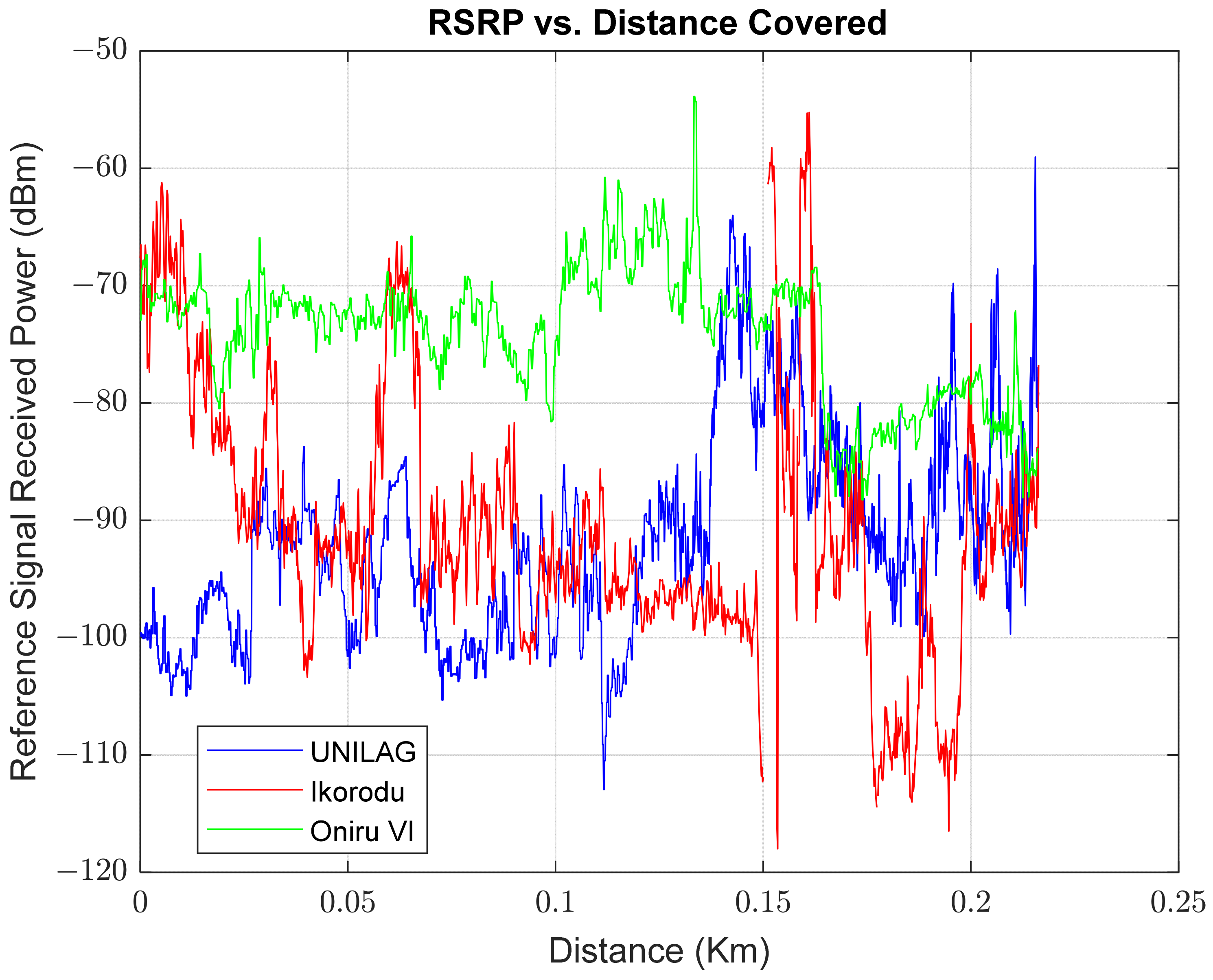

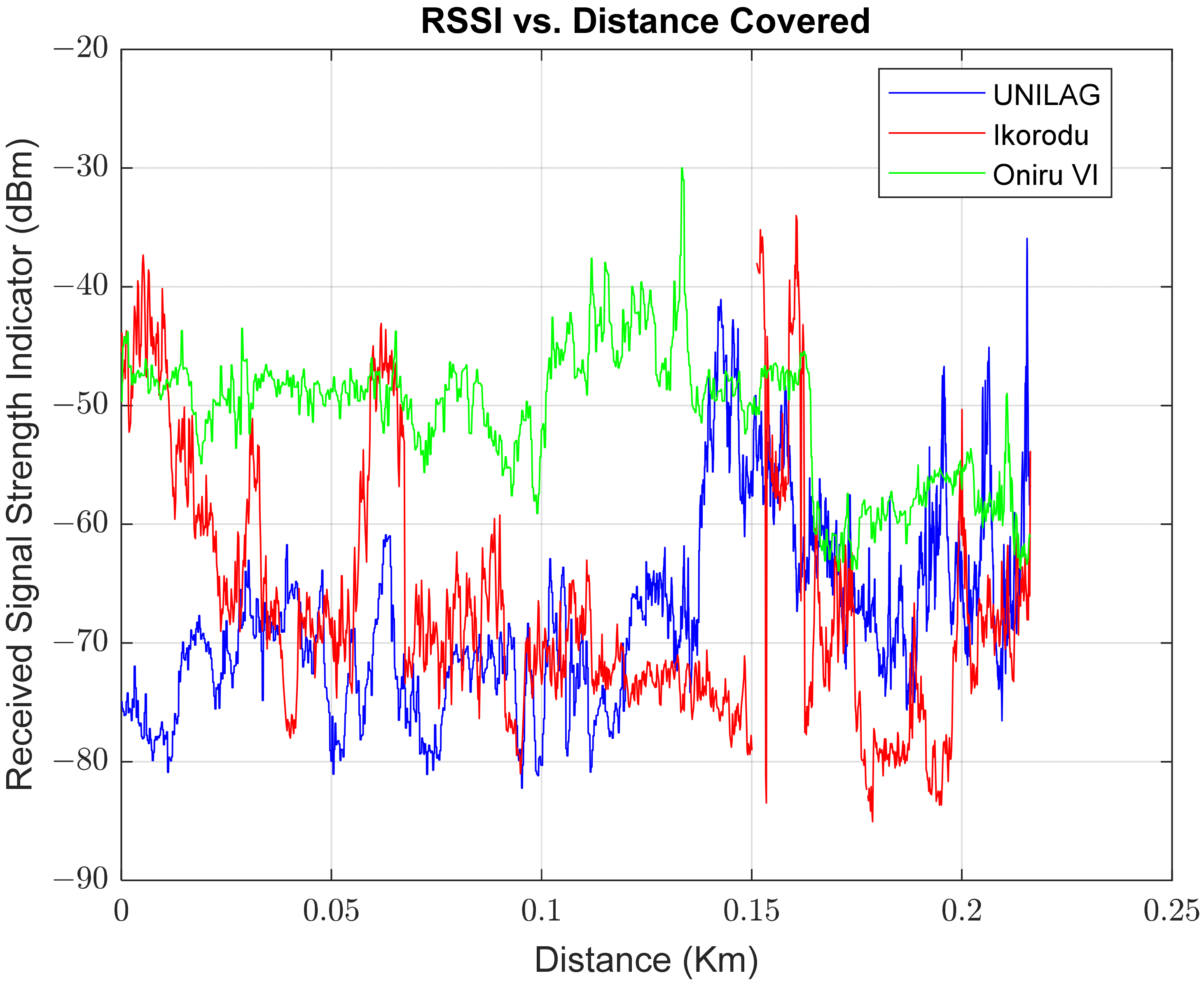
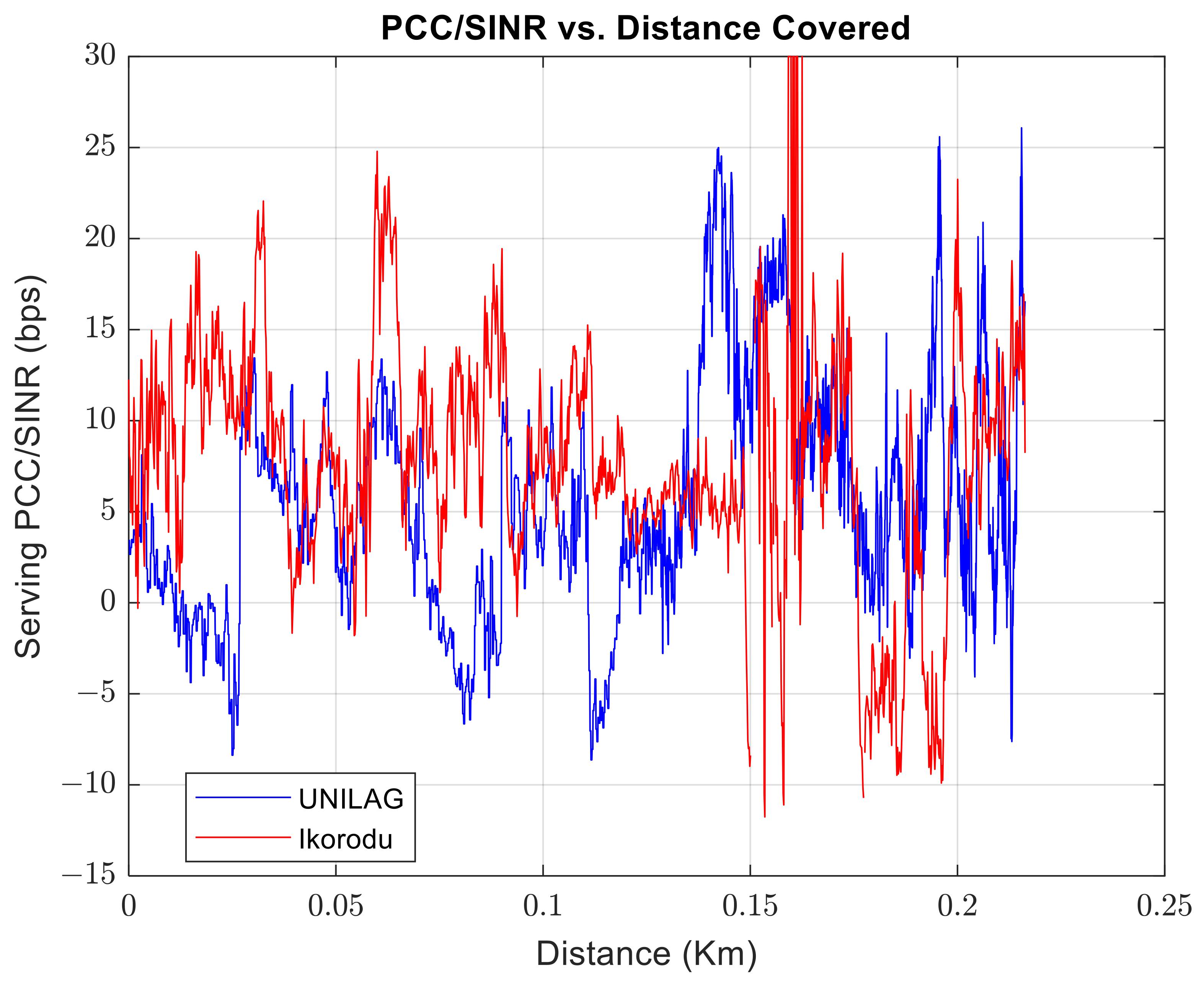
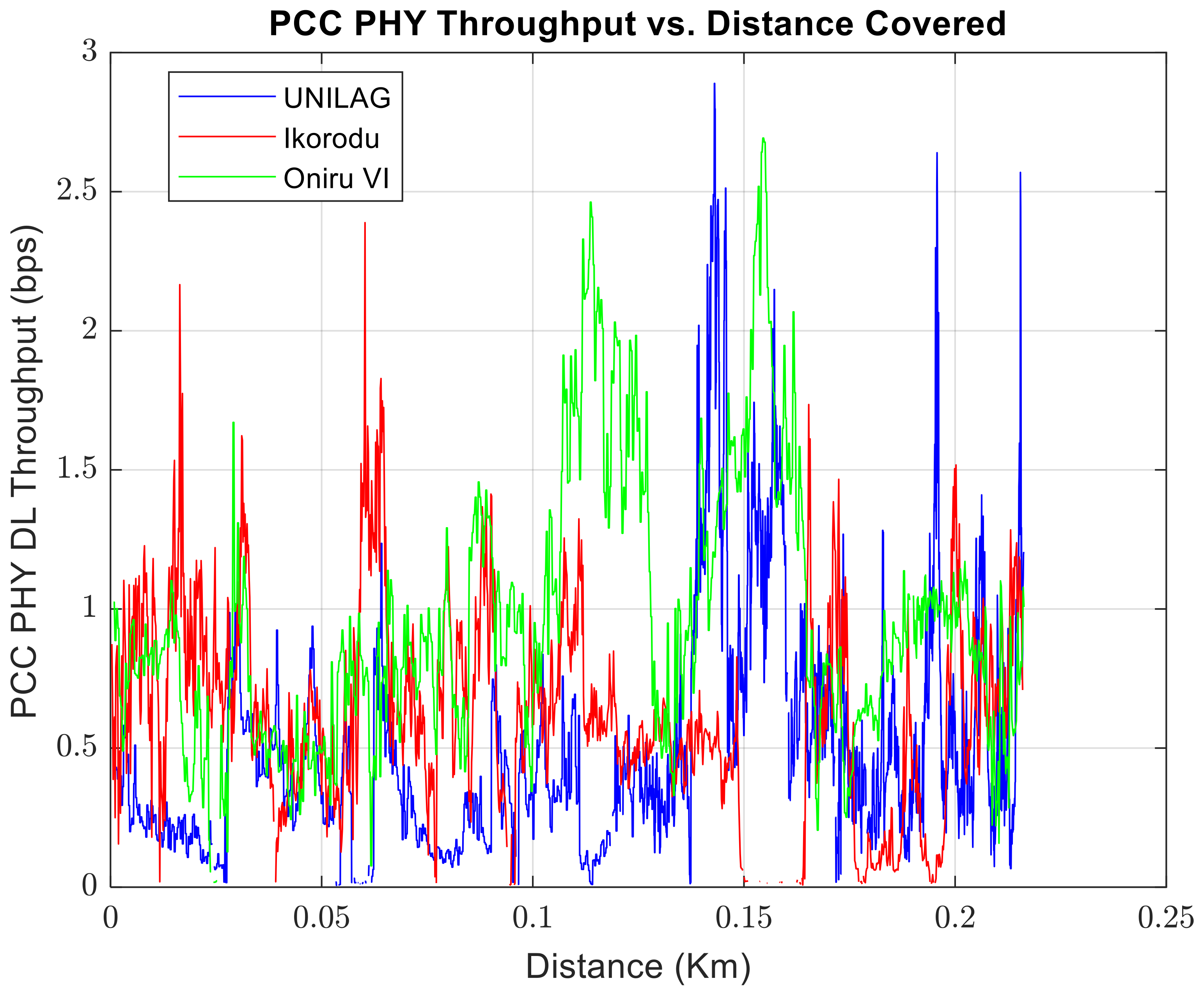

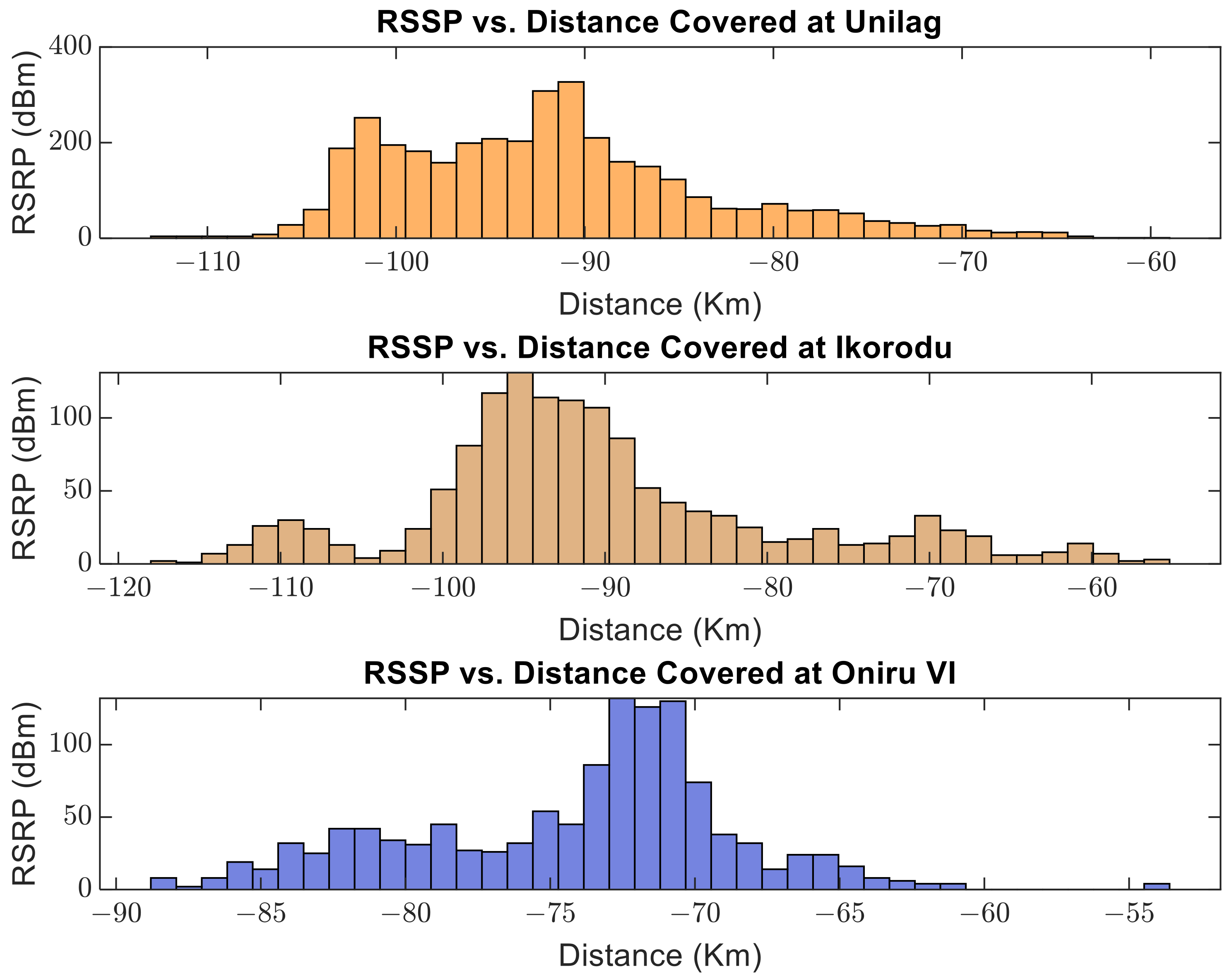
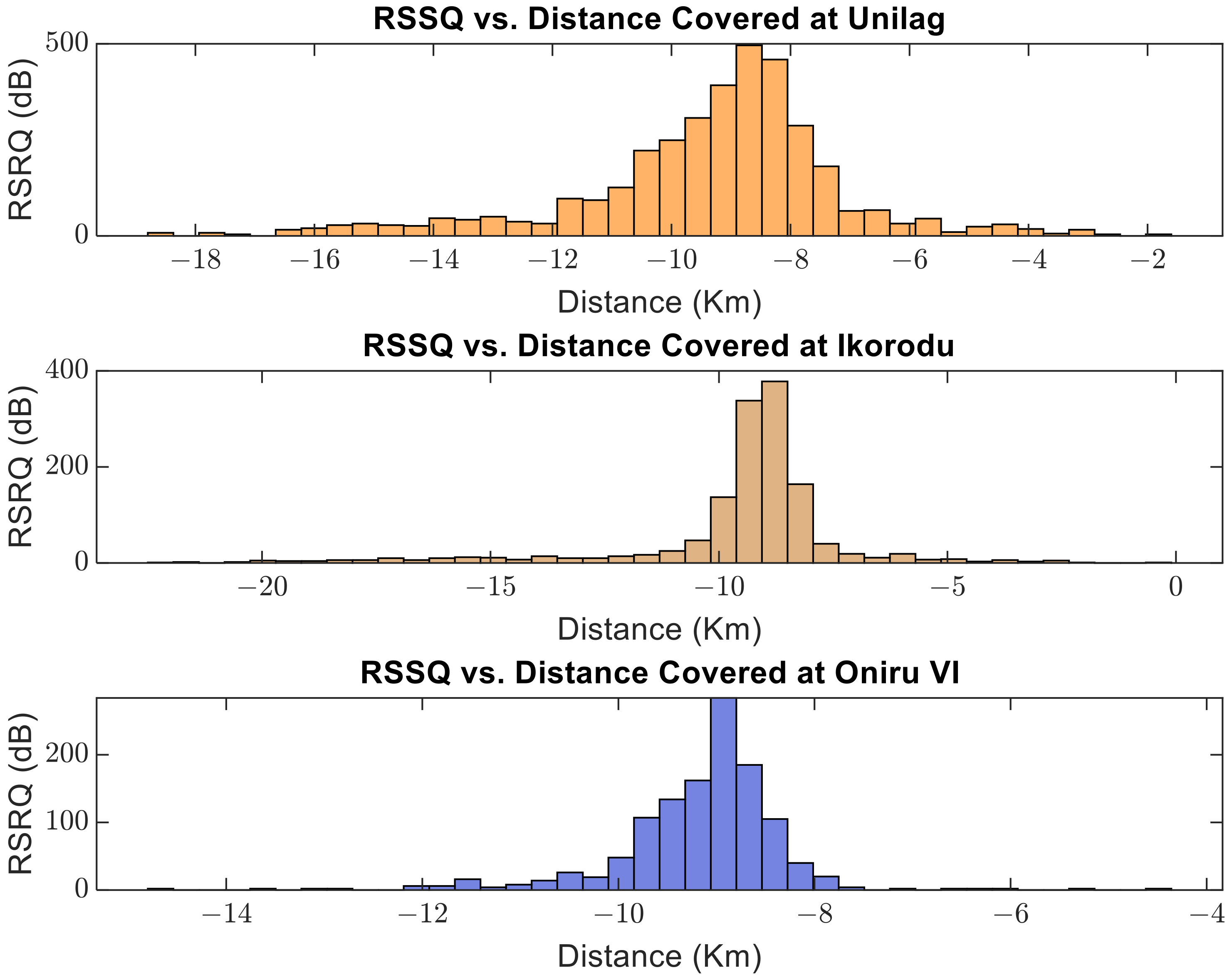



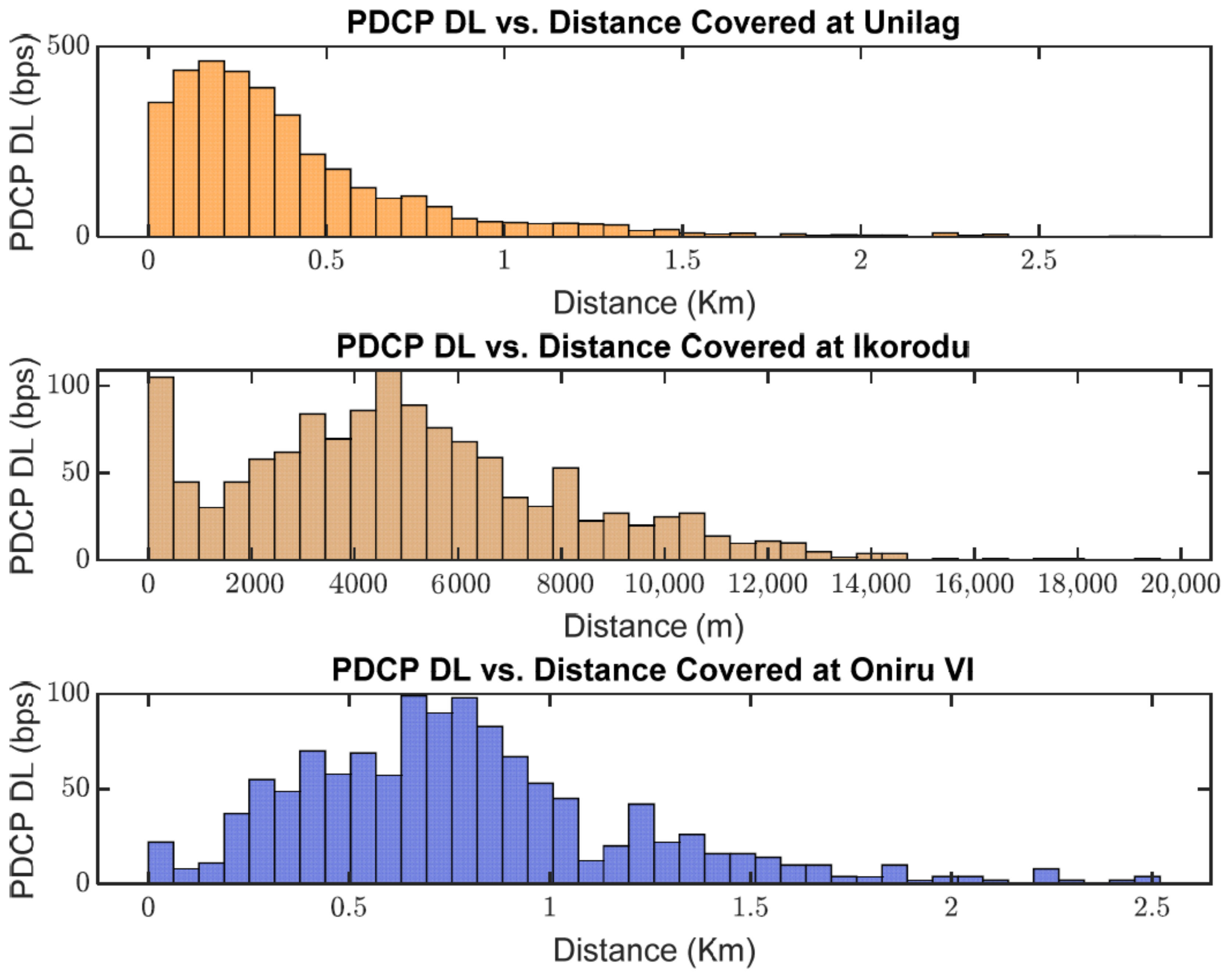
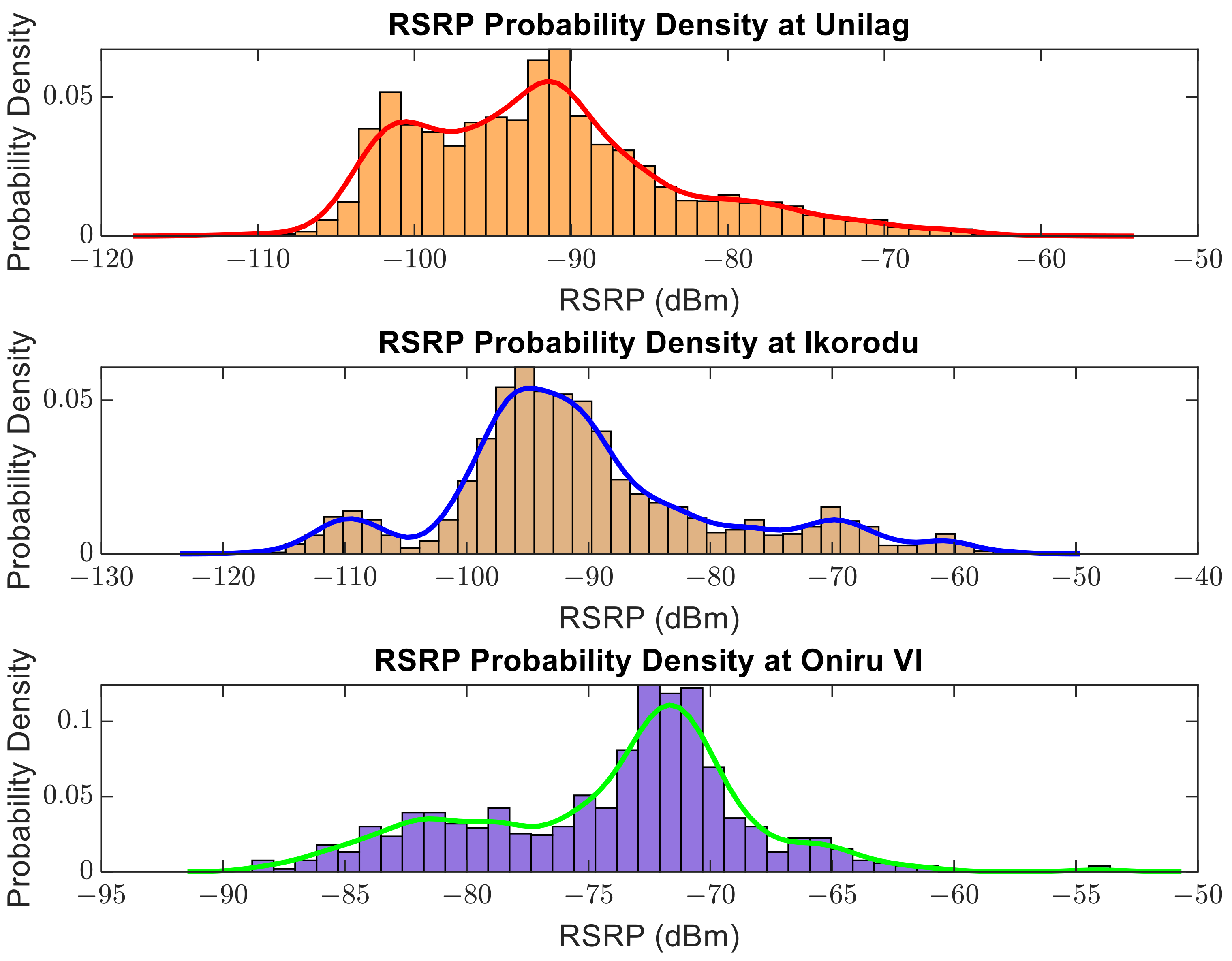
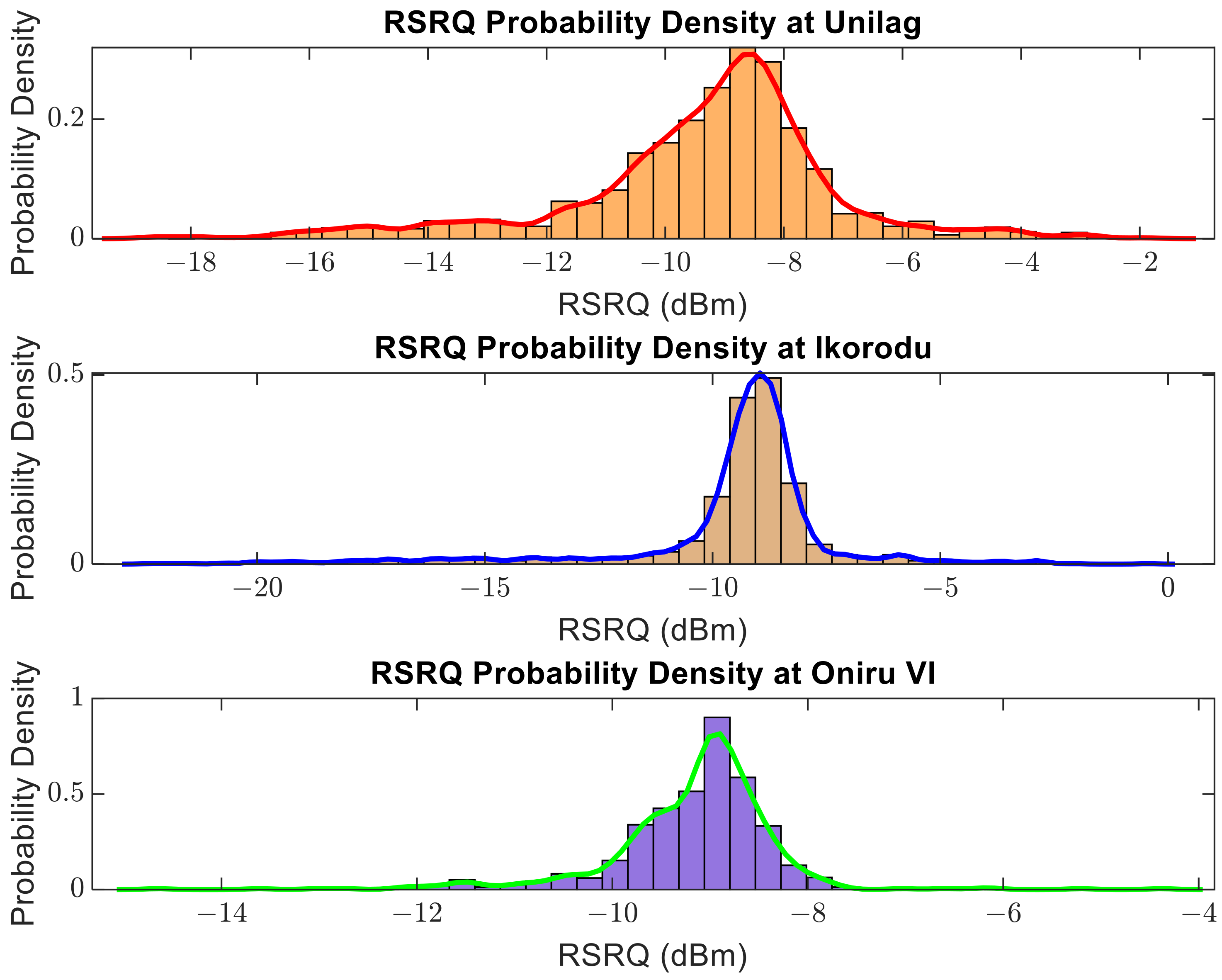



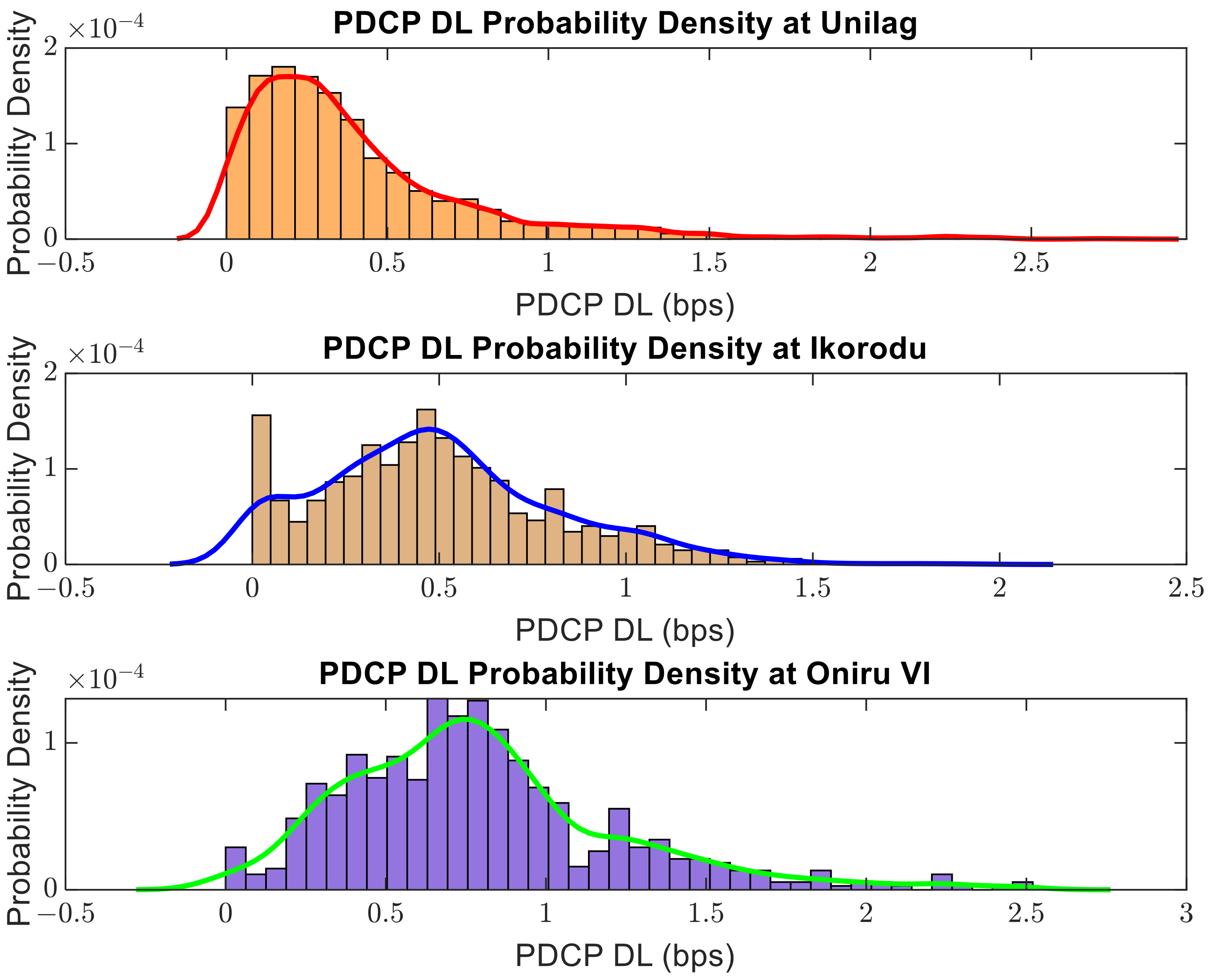
| Reference | Scope and Focus | Contributions | Limitations |
|---|---|---|---|
| [1] | A comprehensive analysis of the existing MBB performance in an urban area: Cyberjaya City, Malaysia. | Provides suggestions, such as the deployment of more indoor hotspots for MBB providers to improve their performance networks. | The suggestions and methods used are solely for the environment studied. |
| [5] | Examination of important challenges in the implementation of 5G. | Extensive documentation of possible 5G technological challenges common in mmWave communication, D2D communication, and security. | No measurement of actual data to ascertain the degree of impact of the challenges discussed. |
| [7] | Development of a 5G navigation system that utilizes the downlink channel in an opportunistic approach. | Presentation of a 5G structure capable of exploiting the downlink channels using an experimental approach in evaluating the performance of the proposed structure with real 5G signals. | Addresses the 5G network, which is yet to be implemented in developing countries such as Nigeria. |
| [8] | Addressing the dramatic complexity of plain maximum likelihood (ML) formulation in direct position estimation (DPE). | The proposition of a reduced-complexity algorithm based on the pseudo-ML approach. | A theoretical approach backed by simulations forms the core of the study. |
| [9] | A detailed review of existing cost-efficient and small-scale testbeds for the investigation of network slicing functionalities in 5G. | Provision of a detailed study comprised of software packages and criteria for small-scale state-of-the-art testbeds for deploying network slicing. | It is unspecified if the methods developed can be applied to areas where the 5G network has not been deployed. |
| [10] | Use of DPOS to reduce the asset portion and energy proficiency in 5G systems. | Provision of minimal solutions that address the energy and asset portion consumption in 5G networks. | A completely theoretical approach devoid of experimental data is adopted. |
| [12] | Prediction of the QoE for over-the-top (OTT) services in LTE technologies and their corresponding effects. | Establishes the need for the monitoring of the QoS and QoE of MBB networks for the improvement of user experience. | The measured data were not optimized, nor were suggestions made as to how MNOs can provide better service for user. |
| [13] | An extensive review of the elements of wireless communication. | Categorization and comparative analysis of varying types of wireless communication technologies. | There is a need for the analysis of specific performance metrics of the technologies discussed. |
| [17] | Extensive measurement and performance analysis of 4G LTE in two urban areas. | An update of measurements and analyses performed in previous work in the environment. | The analysis did not address the question of the distribution and optimization of the QoS in the environments considered. |
| [18] | Experimental measurement and analysis of 4G and 5G networks. | An empirical comparison between 4G LTE and 5G NR networks. | Extensive research and analysis without optimization or suggestion for better QoS in 4G LTE networks. |
| [21] | Design of conformal 4G and 5G MIMO antenna. | Proposal of a MIMO antenna design to be integrated electrically. | Design of MIMO antenna without actual testing and optimization of user experience. |
| [25] | Qualitative QoS strategies that measure the image quality and QoS for download and uploading of images. | Use of deep learning techniques to classify the quality of images. | The work was focused on algorithmic logic, leaving out the place of actual testing, implementation, and optimization. |
| [34] | Performance analysis of the KPIs for the GSM networks in Minna. | Measurement and analysis of network KPIs in Minna, Nigeria. | A costly suggestion of physical modifications of hardware without simulation. |
| Parameters | Values |
|---|---|
| Operating frequency () | 1876.6 MHz |
| Downlink frequency () | 1872.6 MHz |
| Uplink frequency () | 1776.6 MHz |
| Receiver antenna height () | 1.5 m |
| Transmitter antenna height () | 30 m |
| Average building height () | 15 m |
| Average inter-building distance () | 20 m |
| Transmitter-receiver distance () | 100 m |
| Base station transmitter power () | 46 dBm |
| Statistical Measure | RSRP (dBm) | RSRQ (dB) | PCC/SINR (bps) | RSSI (dBm) | DL EARFCN (bps) | PCC PHY DL (bps) | PDCP DL (bps) |
|---|---|---|---|---|---|---|---|
| Range | 53.90 | 16.69 | 34.71 | 46.31 | 0.00 | 28,822.94 | 28,040.11 |
| Minimum value | −112.95 | −18.62 | −8.63 | −82.23 | 1876.00 | 68.00 | 0.00 |
| Maximum value | −59.05 | −1.93 | 26.08 | −35.92 | 1876.00 | 28,890.94 | 28,040.11 |
| Median value | −92.21 | −8.96 | 4.84 | −69.25 | 1876.00 | ||
| Mean value | −91.74 | −9.35 | 5.53 | −68.06 | 1876.00 | ||
| Standard deviation | 8.51 | 2.25 | 6.43 | 7.85 | 0.00 | ||
| Variance | 72.49 | 5.05 | 41.40 | 61.63 | 0.00 | ||
| Skewness | 0.74 | −0.83 | 0.54 | 0.91 | 2.08 | 2.11 | |
| Number of Missing values | 0 | 0 | 0 | 0 | 0 | 87 | 27 |
| % of missing values | 0.00 | 0.00 | 0.00 | 0.00 | 0.00 | 2.41 | 0.75 |
| Statistical Measure | RSRP (dBm) | RSRQ (dB) | PCC/SINR (bps) | RSSI (dBm) | DL EARFCN (bps) | PCC PHY DL (bps) | PDCP DL (bps) |
|---|---|---|---|---|---|---|---|
| Range | 62.74 | 21.94 | 41.76 | 51.05 | 4524.00 | 23,805.70 | 19,223.97 |
| Minimum value | −117.99 | −22.38 | −11.76 | −85.05 | 1876.00 | 80.00 | 0.00 |
| Maximum value | −55.25 | −0.44 | 30.00 | −34.00 | 6400.00 | 23,885.70 | 19,223.97 |
| Median value | |||||||
| Mean value | |||||||
| Standard deviation | |||||||
| Variance | |||||||
| Skewness | 0.66 | −1.92 | −0.18 | 1.02 | 4.10 | 0.57 | 0.66 |
| Number of Missing values | 9 | 9 | 9 | 9 | 9 | 85 | 79 |
| Percentage of missing values | 0.66% | 0.66% | 0.66% | 0.66% | 0.66% | 6.20% | 5.76% |
| Statistical Measure | RSRP (dBm) | RSRQ (dB) | PCC/SINR (bps) | RSSI (dBm) | DL EARFCN (bps) | PCC PHY DL (bps) | PDCP DL (bps) |
|---|---|---|---|---|---|---|---|
| Range | 34.37 | 10.27 | − | 33.94 | 0.00 | 26,750.17 | 24,837.20 |
| Minimum value | −88.25 | −14.65 | − | −63.93 | 1876.00 | 175.80 | 0.00 |
| Maximum value | −53.88 | −4.38 | − | −29.99 | 1876.00 | 26,925.97 | 24,837.20 |
| Median value | −72.63 | −9.02 | − | −49.25 | 1876.00 | − | − |
| Mean value | −74.10 | −9.17 | − | −50.75 | 1876.00 | − | − |
| Standard deviation | 5.58 | 0.86 | − | 5.61 | 0.00 | − | − |
| Variance | 31.09 | 0.74 | − | 31.49 | 0.00 | − | − |
| Skewness | −0.29 | −1.03 | − | −0.32 | − | 1.02 | 1.01 |
| Number of Missing values | 0 | 0 | 1208 | 0 | 0 | 11 | 3 |
| Percentage of missing values | 0.00% | 0.00% | 100% | 0.00% | 0.00% | 0.91% | 0.25% |
| Metric | Mean of Unoptimized Values | Optimized Value | ||
|---|---|---|---|---|
| UNILAG | Ikorodu | Oniru VI | ||
| RSRP (dBm) | −91.74 | − | −74 | −72.54 |
| RSRQ (dB) | −9.35 | − | −9.7 | 9.04 |
| RSSI (dBm) | −68.06 | 1.9396 | −50.75 | 69.42 |
| SINR (dB) | − | − | − | 15.57 |
| RSRP (dBm) | RSRQ (dB) | RSSI (dBm) | SINR (dB) | |
|---|---|---|---|---|
| Optimized Value | −72.54 | −9.04 | −69.42 | 15.57 |
| RMSE of Original Data | 68.51 | 9.62 | 68.51 | − |
| RMSE of Optimized Solution | 10.11 | 4.38 | 9.21 | − |
| Difference in RMSE | −58.40 | −5.24 | −59.30 | 00.00 |
Disclaimer/Publisher’s Note: The statements, opinions and data contained in all publications are solely those of the individual author(s) and contributor(s) and not of MDPI and/or the editor(s). MDPI and/or the editor(s) disclaim responsibility for any injury to people or property resulting from any ideas, methods, instructions or products referred to in the content. |
© 2023 by the authors. Licensee MDPI, Basel, Switzerland. This article is an open access article distributed under the terms and conditions of the Creative Commons Attribution (CC BY) license (https://creativecommons.org/licenses/by/4.0/).
Share and Cite
Imoize, A.L.; Udeji, F.; Isabona, J.; Lee, C.-C. Optimizing the Quality of Service of Mobile Broadband Networks for a Dense Urban Environment. Future Internet 2023, 15, 181. https://doi.org/10.3390/fi15050181
Imoize AL, Udeji F, Isabona J, Lee C-C. Optimizing the Quality of Service of Mobile Broadband Networks for a Dense Urban Environment. Future Internet. 2023; 15(5):181. https://doi.org/10.3390/fi15050181
Chicago/Turabian StyleImoize, Agbotiname Lucky, Friday Udeji, Joseph Isabona, and Cheng-Chi Lee. 2023. "Optimizing the Quality of Service of Mobile Broadband Networks for a Dense Urban Environment" Future Internet 15, no. 5: 181. https://doi.org/10.3390/fi15050181
APA StyleImoize, A. L., Udeji, F., Isabona, J., & Lee, C.-C. (2023). Optimizing the Quality of Service of Mobile Broadband Networks for a Dense Urban Environment. Future Internet, 15(5), 181. https://doi.org/10.3390/fi15050181










